Nishizawa Tekiho
Nishizawa Tekiho ( Japanese 西 沢 笛 畝 , real name: Ishikawa Kōichi (石川 昂 一); born January 1, 1889 in Tokyo ; died October 24, 1965 ) was a Japanese painter of the Nihonga direction of the Taishō and Shōwa periods .
life and work
Nishizawa was born Ishikawa, but took his wife's name to continue her lineage. In 1913 he became a student of Araki Kampo (荒木 寛 畝; 1831-1915) and continued his education after his death under his student and adoptive son Araki Jippo .
From 1915 onwards, Nishizawa showed pictures at the state colored exhibition and in 1934 became a juror for the same. He is particularly known for his studies of traditional Japanese dolls (人形, Ningyō), which he reproduced in woodcut series. In 1931 he was represented at the “Exhibition of Japanese Painting” in Berlin with the painting “Early Spring”. From 1935 to 1936 he traveled through the South Seas to study the sculptures there.
After 1945 he became a member and exhibitor at the Nitten , the successor to the Bunter. He also acted as a member of the Commission for the Protection of Cultural Values, i.e. the commission that looks after the important cultural property of Japan and national treasures of Japan .
In Ogose (Saitama) there is the Tekiho dolls memory art museum (笛 畝 人形 記念 美術館, Tekiho ningyō kinen bijutsukan).
photos
The " Three Friends of the Cold Season "
- ↑ a b c d Owned by the National Museum of Modern Art Tokyo .
- ↑ Shown in Berlin 1931.
- ↑ Tenka (天下) means "The [first] under heaven".
- ↑ a b c woodcut
literature
- Laurance P. Roberts: Nishizawa Tekiho . In: A Dictionary of Japanese Artists. Weatherhill, 1976. ISBN 0-8348-0113-2 .
Web links
| personal data | |
|---|---|
| SURNAME | Nishizawa, Tekiho |
| ALTERNATIVE NAMES | 西 沢 笛 畝 (Japanese); Ishikawa Kōichi (real name); 石川 昂 一 (real name, Japanese) |
| BRIEF DESCRIPTION | Japanese painter |
| DATE OF BIRTH | January 1, 1889 |
| PLACE OF BIRTH | Tokyo |
| DATE OF DEATH | October 24, 1965 |






